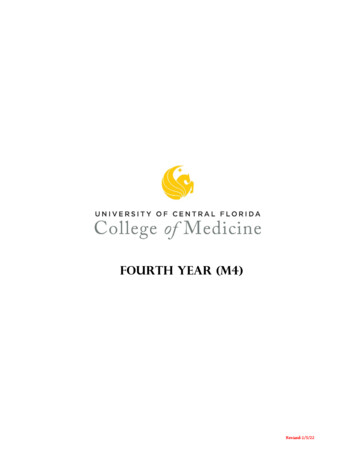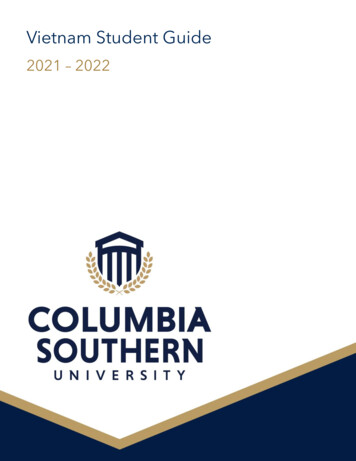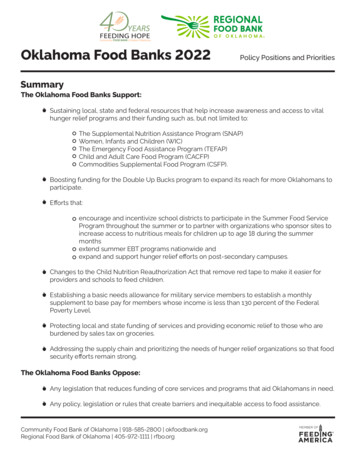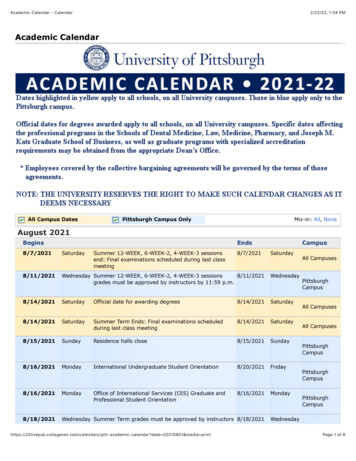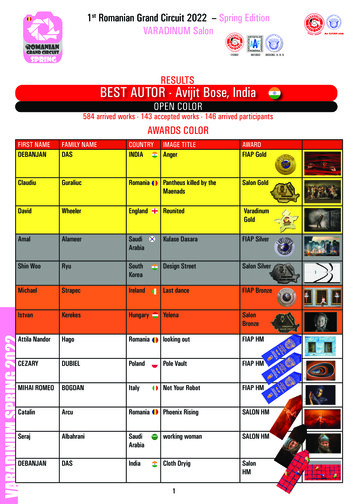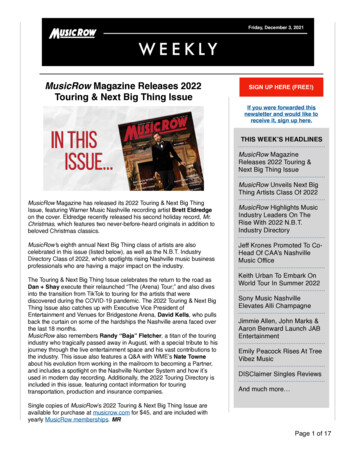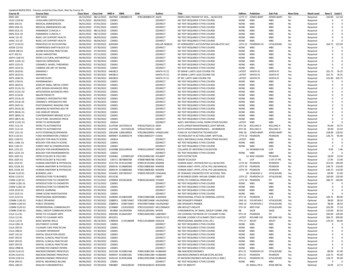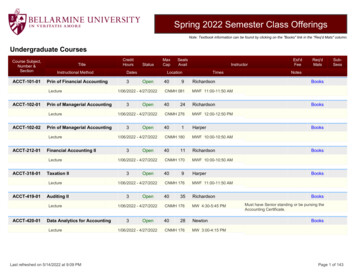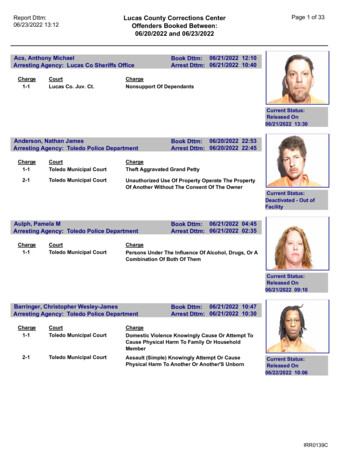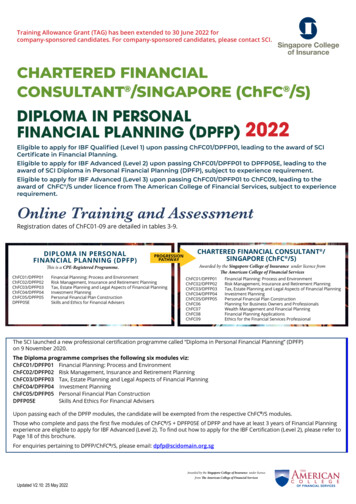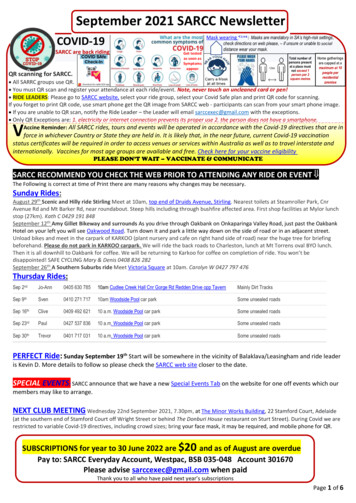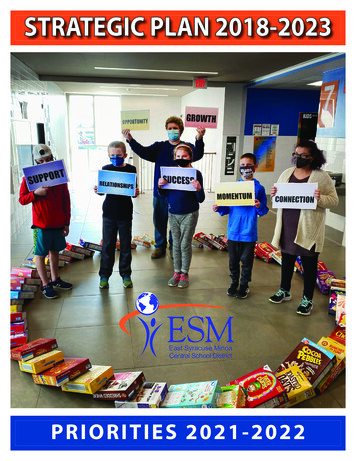
Transcription
STRATEGIC PLAN 2018-2023ESMEast Syracuse MinoaCentral School DistrictP R IORI TIE S 2021-2022
WHO WE AREAt East Syracuse Minoa Central School District, our purpose and aim are clear:Our VisionThe East Syracuse Minoa Central School District will be an exemplary 21st Century learning communitywhose graduates are prepared to excel in a complex, interconnected, changing world.Our MissionThe East Syracuse Minoa Central School District will prepare students for the 21st Century by engaging all learners in meaningfullearning experiences that meet the highest educational and ethical standards in a caring, collaborative learning communitysupported through partnerships with parents and families, businesses, civic organizations, and higher education.Our BeliefsWe believe that: Each individual has dignity and worth. The capacity to learn for each individual is boundless. Curiosity and exploration stimulate innovation and learning. High expectations and challenging curriculum lead to greater achievement. Effort and perseverance are essential to achieve one’s personal best. Positive relationships are fundamental to success and growth. Collaboration within and among school, families and community partners is essential to meet the needs of each student. Acceptance and mutual respect encourages students to take the risks necessary for academic and personal growth. Education prepares students to become productive and responsible citizens who contribute to their communities. Students need to develop their strengths, confidence and resilience to meet the challenges they will face throughout life.OUR COMMUNITYWe are a suburban school district in Onondaga County, minutes from the downtown amenities in the City of Syracuse. Our districtincludes 72 square miles and is a blend of urban, suburban and rural with a wide range of socio-economic groups. We are part ofa region that boasts of more than 44 universities and colleges offering professional and cultural opportunities, including SyracuseUniversity, SUNY Environmental Science and Forestry, Le Moyne College and Onondaga Community College.A strong, supportive business presence with Bristol Myers-Squibb, CORE Federal Credit Union, King & King Architects, Siemens andothers provides numerous career opportunities, as well as opportunities for partnerships to maximize student learning. There are manyopportunities for cultural experiences at the nationally renowned Everson Museum of Art, the Museum of Science and Technology(MOST) with its IMAX theater, the historic Landmark Theatre, the Lakeview Amphitheater, and others.2www.esmschools.org
OUR FRAMEWORK FOR SUCCESS: TURNING GOOD INTENTIONS INTO STRONG RESULTSOur ESM Strategic Plan is our framework for success. Success does not happen by chance. Consistent focus on a number of criticalfactors builds a common vision and sustains trust and commitment with our community, including the deep implementation ofStephen R. Covey’s 7 Habits of Highly Effective People (Covey, 2004) and The 8th Habit (Covey, 2005). These habits provide structure forputting our beliefs into actions, which in turn shapes our results.We focus on building the positive dispositions of our students and staff through multiple practices at ESM, including the teachingof 7 Habits of Happy Kids, the 7 Habits of Highly Effective Teens, and the 7 Habits of Highly Effective People. Our curriculum at ESMincludes targeted Habits of Mind in our instructional units that are framed with the Thoughtful Classroom instructional framework. Ourinstructional and leadership staff all use Harvey Silver’s Thoughtful Classroom framework and resources. Through the Positivity Project,Responsive Classroom, PBIS, Richard and Becky DuFour’s Professional Learning Communities and CASEL Competencies, we prioritizeour teaching, reinforcing and celebrating the positive dispositions in our students and staff.Habit 1: Be Proactive Involving our students, staff and community in theplanning, implementation and monitoring of ourpriorities in the ESM Strategic Plan Staying focused on our “Circle of Influence,” whichare those things that we can influence Modeling and teaching positive behaviorHabit 2: Begin with the End in Mind Having an unrelenting focus on what is best for ourstudents - now and in their future Consistently communicating, building andmaintaining our ESM vision, mission and beliefs Continually reflecting on and evaluating existingprograms, our team and individual actions, andnext steps for improvement based upon our ESMvision, mission, beliefs, and priorities within theESM Strategic PlanHabit 3: Put First Things First Aligning school and department improvement plansand personal growth plans to the ESM Strategic Plan Aligning all of our decisions and actions with ourmission, vision and beliefs Aligning the budget to the ESM Strategic Plan Intentional focus on learning, creative thinking andrelationship buildingHabit 4: Think Win-Win Seeking mutually beneficial relationships by valuingand respecting others’ ideas Approaching all partnerships with students, parents,families, staff and our community with mutual respectto meet common goalsESM Strategic Plan 2018-2023Habit 5: Seek First to Understand, then to be Understood Communicating with each other to align decisions andactions with mission, vision and beliefs Developing and sustaining collaborative partnershipswith families and community-based partners Expanding and strengthening collaborativepartnerships with higher education institutionsand employers to extend learning opportunities forour students and build capacity for our employeesHabit 6: Synergize Through combining strengths of our students, staffand community, positive teamwork and collaboration,greater results are achieved than we could haveachieved independently Deep and consistent implementation of ProfessionalLearning Communities helps us achieve more than anyof us can do individually.Habit 7: Sharpen the Saw Celebrating our successes, balancing and renewing ourresources, and focusing on serviceHabit 8: Find your Voice and Inspire Others to Find Theirs Emphasizing students’ voices, aspirations, and ideas incontinually shaping our ESM Strategic Plan andguiding reflections Empowering parents/caregivers and family membersto embrace partnership and continuous learning as apriority3
Social and emotional learning is key to the educationalprocess and human development and advances equityfor students. Multiple decades of research indicates thatan education rich in social emotional learning (SEL) getsresults and leads to increased academic outcomes, up to11 percentile points. The benefits and impact of socialemotional learning and programming can positivelyimpact academics, conduct, emotional distress, poverty,substance abuse, and overall lifetime outcomes.At ESM, we believe it is critically important to include the SEL competencies as a framework around which we align practices and policies for all. These competencies identifywhat students from PK-12 should be able to do for success in school, the community,and in careers. Well-designed, evidence-based programs and practices are foundationalto the successful implementation of SEL. We believe it is most beneficial to “integrateSEL throughout the school’s academic curricula and culture, across the broader contexts of schoolwide practices and policies, and through ongoing collaboration withfamilies and community organizations.”Taken from rg
CASEL’s (Collaborative for Academic and SocialEmotional Learning) SEL framework “fostersknowledge, skills, and attitudes across five areas ofcompetence and multiple key settings to establishequitable learning environments that advance students’learning and development” (CASEL, 2020). Self-awareness: The abilities to understand one’s own emotions, thoughts,and values and how they influence behavior across contextsExamples: Identity, Integrity, Emotional Intelligence Self-management: The abilities to manage one’s emotions, thoughts, andbehaviors effectively in different situations and to achieve goals and aspirationsExamples: Self-Care, Self Advocacy, Time Management Social awareness: The abilities to understand the perspectives of andempathize with others, including those from diverse backgrounds, cultures,and contextsExamples: Empathy, Compassion, Gratitude Relationship skills: The abilities to establish and maintain healthy andsupportive relationships and to effectively navigate settings with diverseindividuals and groupsExamples: Interpersonal skills, Communication skills (including digitalcommunication) Responsible decision-making: The abilities to make caring and constructivechoices about personal behavior and social interactions across diverse situationsExamples: Open-minded, Curious, Solution-focused, Reasoned judgment,Critical thinking, Self-ReflectionFor additional detail: -SEL-Framework-11.2020.pdfESM Strategic Plan 2018-20235
FOCUS AREA 1TEACHING AND LEARNINGWe will improve academic outcomes for all students and ensurestudent engagement and achievement by strengthening ourdocumented Tier 1 curriculum, implementing evidence-basedinstructional strategies at all tiers, and aligning assessmentand grading practices to essential learning standards andskills. Our goal is to ensure all students reach our ESM visionthrough instruction shaped by our guaranteed and viablecurriculum that is vertically and horizontally aligned. Thisenables teachers to provide consistent rigorous learning goalsfor all students and enables students to set, monitor and reflecton personal learning goals aligned with priorities. We strive toimprove our system so all instructional staff implement highlyeffective teaching practices to maximize student learning.Student learning is measured in multiple ways, and studentsare provided meaningful feedback to improve their learningand content knowledge. Through the work of ProfessionalLearning Communities, collaborative teams work collectively toensure high levels of learning for all students through a multitiered system of support (MTSS), that focuses on high levels ofacademic and social-emotional learning.GOALAll ESM students will be supported through a multi-tiered system of supports thatfocuses on high levels of academic, social-emotional, and grade-level appropriatelearning, that is culturally responsive and inclusive of all members of the learningcommunity.PRIORITIES Evidence based Social-Emotional Learning (SEL) programming in place at allgrade levels. Accelerated learning through a multi-tiered system of supports (MTSS), withcontinued focus on Tier 1 curriculum, and a renewed focus on Tiers 2 and 3 Culturally Responsive Pedagogy and Practices Professional Learning Communities will engage in data-driven discussionsto target student learning across all content areas, including the use ofacademic and social emotional learning data, that focus on high levels oflearning for ALL students6www.esmschools.org
ACTION STEPS FOR 2021-2022 Embed Social Emotional Learning assessment tools to align necessary supports Incorporate CASEL competencies into all classrooms Prioritize and unpack essential learning standards focusing on acceleration andgrade-level access, with appropriate scaffolds for all students Increase awareness and implementation of culturally responsive practices andpedagogy to ensure equitable access for all students Strengthen Professional Learning Communities, through regular collaborativereviews of data that inform all instructional decisions Implement evidence-based academic and behavioral approaches at all tiers ofinstruction to address new and unfinished learning Provide ongoing standards-based feedback and grades to students thatrepresents the student’s academic progressESM Strategic Plan 2018-20237
FOCUS AREA 2TECHNOLOGY FOR TEACHING AND LEARNINGWe will improve academic outcomes for all students andincrease student engagement and achievement by implementingthe ESM student technology standards into innovative learningmodels across all content areas. Integrating technology forteaching and learning allows us to infuse classrooms withdigital tools and expand our course offerings, experiences,and learning materials. Alignment of digital resources willallow for more consistent access and provide the abilityto more effectively communicate with all stakeholders.Continued implementation of the SAMR model (substitution,augmentation, modification and redefinition, by Dr. RubenPuentedura), along with integration of the technologycompetencies, will increase student engagement and motivationand accelerate learning.GOALImprove academic outcomes for all students and increase student engagement andachievement by implementing the ESM student technology standards into innovativelearning models across all content areasPRIORITIES Standardize the technology platforms across the district. Ensure digital equity and access to resources for all stakeholders Embed technology competencies into all subject areasACTION STEPS Evaluate and align technology learning platforms that are consistent,effective and reliable Support the implementation of ParentSquare Develop and share on-demand professional learning tutorials for staff Provide digital resources to all students and families Embed keyboarding and basic computer skills, with a focus on integrationof SAMR and technology competencies at all grades8www.esmschools.org
FOCUS AREA 3COMMUNICATION AND COMMUNITY ENGAGEMENTWe will improve academic outcomes for all students andensure student engagement and achievement by enhancingcommunication with families related to curriculum, learning andsafety. Thoughtful, intentional communication with families iscritically important so they may understand what their childrenare learning and be able to further support them. Regular familyengagement and communication between home and schoolsimproves student achievement and outcomes. Additionally, wewill seek out and enhance partnerships with community members,businesses and organizations. These ongoing partnershipsstrengthen student learning and offer opportunities for real worldexperiences.GOALWe will improve academic outcomes and social-emotional development for all studentsby increasing the opportunities for family and community involvement, with a moreintentional focus on inclusivity of all families.PRIORITIES Implement ParentSquare Increase communication about how to support students at home(both academics and socially and emotionally) Strengthen participation and engagement of families from diversebackgroundsACTION STEPS Implement and train all stakeholders on the use of ParentSquare, throughcoordinated messaging PK-12 Improve family resources available on the website, including those to supportsocial emotional learning Identify additional stakeholders from diverse groups to provide opportunitiesfor voice and to share perspectivesESM Strategic Plan 2018-20239
FOCUS AREA 4EMPLOYEE ENGAGEMENT AND PROFESSIONAL LEARNINGWe will improve academic outcomes through Professionallearning for all staff. Through continued professional learningand opportunities for staff to learn from one another, teachers andstaff grow in their practices. All instructional staff participatein research-based professional development, aligned with ourStrategic Plan priorities and receive support to effectivelyimplement these practices. This prioritized professional learningincreases our collective capacity, content knowledge and oureffective use of current instructional strategies to meet the learningneeds of all students. In addition, we will build the capacity of ouracademic system by ensuring all non-instructional staff participatein professional development to continually improve our practicesthat support our learning system for our students.GOALWe will seek to diversify our workforce, while providing relevant professional learning toall stakeholders related to all focus areas.PRIORITIES Staff Hiring, Recruiting and Retention Equitable opportunities for professional learning available for all staff, including Professional learning communities Multi-tiered system of supports Culturally Responsive Pedagogy and PracticesACTION STEPS 10Recruit to diversify workforce in all areas and levelsDevelop Employee Engagement and Accountability website for staffBuild staff morale through ongoing activitiesAlign professional learning to the Strategic Planwww.esmschools.org
FOCUS AREA 5LEARNING ENVIRONMENT SYSTEMS AND STRUCTURESWe will improve academic outcomes through the integration ofall learning environment systems, structures, components andprocesses in a fiscally sound district. The systems and processesthat support our learning environment must be coherent,efficient, and aligned to our vision, mission and beliefs. Aswe continue with Our Elementary Objective capital project,Woodland and Fremont school communities will move backinto newly-renovated, state-of-the-art school buildings whileconstruction is ongoing at Minoa, Park Hill and East SyracuseElementary.GOALImprove academic outcomes of all students and ensure student engagement andachievement by providing a safe, welcoming Pre K-5 environment that helps studentsand families feel safe, valued, and included during our continued Elementary Objective.PRIORITIES Create and implement a vision for optimal indoor and outdoor learning spacesto be integrated into the design planACTION STEPS Coordination of next phase of Elementary Objective Continue relocation meetings as needed Develop operational plans for arrival/dismissal, safety plans, etc. Communicate progress with stakeholders Establish plans for safe and welcoming environments for learning at all levels Finalize selections for Phase II buildings and review outdoor learning spacesESM Strategic Plan 2018-202311
OUR LEADERSHIPBoard of EducationMrs. Debbie Kolod - PresidentMr. D. Paul Waltz - Vice PresidentMrs. Lori AirdMr. John AlbaneseMrs. Susan CainMrs. Tracy CallahanMrs. Leah CushingMrs. Kay GalleryMrs. Dee SeamanExecutive CabinetDr. Donna J. DeSiato, SuperintendentDr. Thomas B. Neveldine, Deputy SuperintendentN. Shane Hacker, Executive Director of Curriculum, Learning and AssessmentKieran O’Connor, Executive Director of Planning, Development and TechnologyKatherine Skahen, Executive Director of School Business AdministrationDouglas Mohorter, Executive Director of Employee Engagement and AccountabilityStrategic Action Leadership TeamChrista AndrusGreg AvellinoMarshall BaileyAmy BrennanPam BuddendeckBeth CrumpKelsey DeLanyTom DeckerChristy FaheyGary GerstGina TerziniGina GabrielMichele GipeKim GoodeN. Shane HackerPam HerringtonJustine HillPaul HolzwarthSarah KelleySue KowalskiShelly LaMarcheCatherine MartinDenise McGinleyKevin MichaudDouglas MohorterAlyssa MoskowitzShadia NesheiwatKieran O’ConnorLeslie PcolinskyRon PerryAmy ShieldsErin SimmonsKatherine SkahenTom SweeneyCheryl WestAshleigh WilsonJamie Zimmer407 Fremont Road, East Syracuse, NY 13057esmschools.org
These habits provide structure for putting our beliefs into actions, which in turn shapes our results. We focus on building the positive dispositions of our students and staff through multiple practices at ESM, including the teaching of 7 Habits of Happy Kids, the 7 Habits of Highly Effective Teens, and the 7 Habits of Highly Effective People.

